Key events of the Normandy Landings
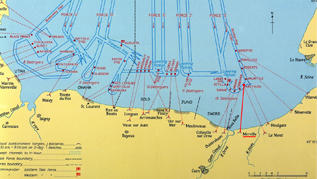
The Allies had been preparing to land on Europe’s beaches since 1942, and in 1943 it was decided that it would be better to land on the coast of Normandy rather than the beaches of Pas de Calais.
The Normandy landings, codename Operation Neptune, constituted the first phase of Operation Overlord, whose ultimate aim was to liberate Europe.
There were three phases to the landing operation: first came the airborne landings, followed by air attacks and naval bombardments, and, finally, amphibious craft landed troops on the beaches.

Airborne landings
Parachute landings took place at either end of the beach-head, to protect both flanks of the allied assault troops arriving by sea. Between midnight and 1 a.m., the American 82nd and 101st airborne divisions were parachuted down near Sainte-Mère-Eglise (Manche), while the British 6th airborne division landed near Ranville.

Air and naval bombardments
That same night, June 5th-6th, some 2,000 bombers dropped nearly 8,000 tons of explosives on the German artillery batteries located within the assault zone. At dawn, these airborne attacks were followed by naval bombardments, which began half an hour before the troops landed.
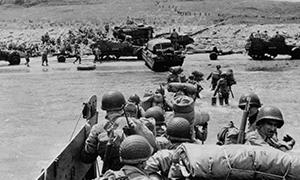
Beach landings
5 landing zones had been identified. General Bradley’s First American Army were to land on Utah and Omaha beaches, on either side of the Vire estuary in Veys Bay, while the British Army, including, amongst others, many Canadian troops, landed at beaches code-named Gold, Juno and Sword, located between Arromanches and Ouistreham. Owing to variations in the tide, the landings had to take place at different times – 6.30 a.m. for Utah and Omaha beaches, and 7.30 a.m. for Gold, Juno and Sword.
For General Eisenhower, the operation’s commander-in-chief since December 1943, one of the primary objectives was to take the port of Cherbourg. This was why he had decided to add a landing beach on the eastern coast of the Cotentin peninsula, as the landings had originally been planned to take place between Grandcamp-Maisy and Courseulles-sur-Mer only. Once it had been decided that troops would land at Utah, there also had to be landings at Omaha beach, because leaving a gaping hole between Utah and the beaches where the British were due to land was completely out of the question. Despite the risks posed by the configuration of the beaches, there was no choice but to land forces at Omaha beach, there being no other suitable beaches between the mouth of the river Vire and Arromanches.
Airborne operations
On either side of the assault zone, airborne troops were to land before those arriving by sea. The troops landed at around half past midnight, with the aim of protecting the flanks of the seaborne attack.
The British sector
British forces belonging to the 6th Airborne Division were tasked with protecting the eastern flank, along the river Orne.
Their objectives:
1st raid = Bénouville and Ranville bridges
2nd raid = Merville-Franceville gun batteries
The 6th Airborne Division’s first raid
Major Howard’s troops were instructed to take the bridges over the river Orne and the canal at Ranville and Bénouville. These bridges were the only way across the river between Caen and the sea, and they were to be taken intact and held until the commandos landing at Sword beach arrived. The Allies needed these bridges so that reinforcements could reach the sector where the 6th Division was landing, which stretched from the Orne to the Dives (an area where the Allies expected the Germans to fight back strongly).
At around half past midnight, three gliders belonging to Major Howard’s regiment landed close to Bénouville. The element of surprise was so effective that the German sentries guarding the bridge hardly put up a fight, and the objective was quickly achieved with the Germans either overcome or taking flight. The same operation took place at almost exactly the same time at Ranville bridge on the river Orne, with equal success. Major Howard’s men then had to deal with the German counter-attack until they were relieved.
Reinforcements arrived in the form of some fifty gliders, which landed at about 3 a.m. in the area around Ranville, the landing zone having been prepared and marked out by the soldiers who had taken the bridges. The general staff of the 6th Airborne Division, commanded by General Gale (the first British general to set foot on Normandy soil), now landed, accompanied by nearly a thousand troops, plus anti-tank guns and jeeps.
From then on the two bridges were solidly defended and the German counter-attack repulsed. In addition, between midday and 1 p.m., commandos from the first brigade to have landed on Sword beach that morning joined forces with the 6th Airborne Division.
The 6th Airborne Division’s second raid
Lieutenant-Colonel Otway’s battalion had to take Merville battery. Unfortunately, Otway only had 150 men with whom to attempt this, as nearly 500 paratroopers had not been dropped in the right place and were scattered across the Normandy countryside. This engendered huge losses, as many were drowned in the Dives marshlands, which had been deliberately flooded by the Germans. Moreover, many of the gliders carrying heavy equipment came down in the Channel, as strong gusts of wind caused the towing cables to break. At about 4.30 a.m., Lieutenant-Colonel Otway’s ‘red berets’ began their assault. The ensuing hand-to-hand fighting resulted in the deaths of most of the German gunners and half the young British soldiers.
The American sector
The American parachute drop took place on the western flank, on the Cotentin peninsula near Sainte-Mère-Eglise. The American 82nd and 101st Airborne Divisions were to secure the hinterland and the difficult beach exits, to protect the men arriving by sea.
The U.S. 101st Airborne Division
As they arrived over their drop zone at around 1.30 a.m., the aircraft carrying paratroopers of the 101st Division encountered severe flak, and the pilots tried to avoid the danger by flying beyond the drop zone – with catastrophic consequences, as the paratroopers found themselves scattered throughout the countryside. A scant 1,000 men succeeded in assembling quickly and taking the German battery at Saint-Martin-de-Varreville. The remaining 5,000 spent a long, anxious night, lost in the Cotentin countryside.
The U.S. 82nd Airborne Division
The troops of the 82nd Division were dropped either side of the Merderet river, with orders to capture the village of Sainte-Mère-Eglise. The Germans had flooded the marshes in this sector far more than could be detected from the Allies’ aerial photographs, resulting in the death by drowning of many paratroopers, dragged down by the heavy equipment they carried. Fortunately, one of the division’s regiments escaped disaster, and managed to land close to its target – too close, in fact, in the case of one of the groups, which came down right in the middle of the village square, only to be shot before the villagers’ eyes by a German squad investigating an accidental house fire. Sainte-Mère-Eglise was captured at around 4.30 a.m.
Beach landings
| Landing times | Sectors | Beaches |
| 6.30 a.m. | Utah | Sainte-Marie-du-Mont |
| 6.45 a.m. | Omaha | Vierville, Saint-Laurent, Colleville |
| 7.25 a.m. | Gold | La Rivière, Le Hamel |
| 7.45 a.m. | Juno | Saint-Aubin, Bernières, Courseulles, Graye, Vaux |
| 7.25 a.m. | Sword | Ouistreham, Riva Bella, Colleville, Hermanville |
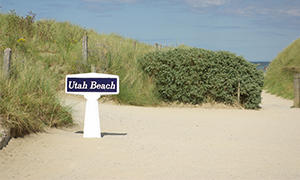
UTAH BEACH
Utah was the only landing sector located in the Manche department.
The first wave of U.S. 4th Infantry Division troops landed at Utah beach at around 6.30 a.m. The intention was to land in front of Varreville Dunes, but strong off-shore currents took them 2 kilometres further south. This in fact turned out to be advantageous, as the Americans were now able to land in a sector that was less heavily defended.
All bar two of the amphibious DD (Duplex Drive) tanks came safely to shore (except 2) and cleared the beach exits to give access to the hinterland. While the first troops advanced and joined the 101st Airborne Division at about 1.00 p.m., engineers remained behind to defuse the mines on the beach.
Relatively speaking, the landings on Utah beach can be said to have gone more-or-less according to plan, with Utah suffering the least number of losses overall.
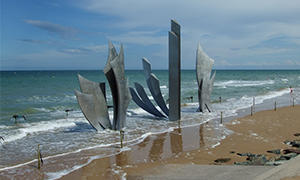
OMAHA BEACH
The first wave of the assault was due to land at 6.30 a.m.
Here, a long crossing on rough seas resulted in significant sea-sickness, while strong off-shore currents caused many of the landing craft to miss their objective. Moreover, when the GIs landed at Omaha beach, the defending troops were stronger than expected – and there were more of them. Instead of the expected veteran regiments of the 716th Division, they found the 352nd Division, consisting of trained and well-equipped troops under the command of General Kraiss – apparently news of the change had not reached London. The French Resistance in the Calvados area had sent London all sorts of information about the Germans during the Occupation, but the Alliance network, operating in the Omaha sector, had been dismantled in 1944, which might explain why little or no information had reached London about the German troop changes.
It should also be noted that the German defences had largely escaped the bombing and naval gunfire earlier, which meant that the initial assault forces landed on a beach where the German defence system was all but intact.
Men fell in their hundreds, while landing craft caught fire and sank. Whole units were decimated without even setting foot on dry land. The rough seas caused amphibious tanks that had been launched too far from the shore to sink, rendering them unable to back up the infantry units. When the second assault wave arrived at 7 a.m., the first was still stuck where it had landed, which only served to increase the crowded confusion reigning on the beach, itself reduced by the rising tide to a narrow strip jam-packed with men. Many of the injured were drowned, abandoned where they fell, and the sea also covered and hid obstacles on the beach that the first assault wave was to have cleared. Numerous landing craft ran into each other as they tried to avoid traps set by the Germans, whilst others exploded as they hit mines attached to stakes, now partially hidden by the rising tide.
No more reinforcements were sent after 8.30 a.m. as there was no room for them to land. Fortunately, however, after these initial hours of tragedy, towards the end of the morning the battle began to turn in the Americans’ favour. There were a number of reasons for this. The American warships sailed as near as possible to the shore, destroying a large number of German positions, while energetic officers regrouped the disoriented troops and managed to scale the bluffs and seize the German defences from behind.
Lastly, the German troops were beginning to tire and no reinforcements arrived to relieve them.
Despite continuing severe losses, the Americans began to reach the plateau overlooking the beach, while engineers cleared it of obstacles so that vehicles could gain access to the valleys behind. Throughout the afternoon, troops and equipment continued to land on Omaha beach.

POINTE DU HOC
Pointe du Hoc was considered to be the most dangerous German fortified stronghold in the American assault zone.
The artillery battery was a potentially serious problem for the landings on both Omaha and Utah beaches, so the Americans decided that, in addition to bombing from the air and naval gunfire, an assault force would be sent to secure the position before troops began landing on the beaches.
The task of taking Pointe du Hoc by force was entrusted to Colonel Rudder and the 2nd Ranger Battalion.
At around 4.30 a.m. on June 6th, Colonel Rudder’s 225 Rangers set off for Pointe du Hoc in 10 assault landing craft, accompanied by another 2 carrying equipment and 4 amphibious trucks. They were supposed to arrive at 6.30 a.m., just as the naval gunfire ceased, but owing to a navigational error, caused partly by the weather conditions, the operation was delayed by 40 minutes, which gave the Germans time to regroup after the naval gunfire. What was more, some of the Rangers’ landing craft had missed their objective, and they therefore had to make their way back along the coast to Pointe du Hoc under the very noses of the Germans. Various landing craft and trucks had already been sunk during the crossing.
The Rangers finally made it to shore at 7.10 a.m., and attacked the east side of Pointe du Hoc they were supposed to have mounted an attack from both sides, had there not been a navigational error. Rocket-launchers fired grapnels and climbing ropes all over the cliffs, and the Rangers began to scale the cliff-face, while the German soldiers above threw grenades, opened fire with machine guns, and tried to cut the ropes. Just 20 minutes later, the remaining 150 Rangers reached the top of the cliff and searched for their objective amongst the chaos.
As they advanced, the Rangers were astounded to discover that there were in fact no guns to be seen! Neither in the casemates, nor in the concrete bunkers. Instead, they found wooden beams covered with nets so as to better conceal the subterfuge. After the aerial bombardments that had taken place in April 1944, the Germans had removed the guns and hidden them 1 kilometre further inland in a little hedged lane, where they were found and destroyed by a group of Rangers. Meanwhile, those who remained on the site fought a bloody battle with the Germans, and the siege continued until the morning of June 8th, 1944.
Of the 225 Rangers who took to the sea to carry out the assault on Ponte du Hoe that June 6th morning, 135 were killed, wounded, reported missing in action, or taken prisoner. Only 90 were still fit for battle on the morning of June 8th 1944, when reinforcements arrived.

GOLD BEACH
Securing the Gold beach sector was assigned to 50th Division of the British Army, who began to land at 7.30 a.m.
The landings began an hour after the first wave of American troops had begun their assault, owing to the differences in the tides. The actual landing beach consisted of just a 5 kilometre stretch between Asnelles and Ver-sur-Mer.
The division had three objectives:
to take Bayeux,
to block the main Bayeux-Caen road so that German tanks could not reach the American beaches,
to rendez-vous with the American troops at Port-en-Bessin.
As with the other beaches involved in the D-Day landings, there was no escape from tragedy and horror as landing craft were blown up and wounded soldiers were crushed by tanks. Nevertheless, the situation was less disastrous than at neighbouring Omaha beach.
Conditions for the British had in fact been more favourable.
Firstly, the terrain was largely flat. The beaches in this British sector were completely different from the American ones: no cliffs, no lagoons, just a flat landscape slightly above the beaches.
Secondly, the British came ashore with a variety of tanks, which gave the infantry troops good support.
Lastly, the German defence comprised the 716th Infantry Division – poorly equipped and consisting chiefly of veterans.
German forces finally managed to halt the allied advance towards Arromanches at Asnelles/Le Hamel. Further east, however, the British encountered less resistance, as the sector was being held by Russian troops, most of whom had been conscripted by force and preferred to take flight or give themselves up rather than fight.
The batteries at Ver-sur-Mer, which had been badly damaged by the previous night’s aerial bombardment, offered little resistance, while those at Longues, which could hit both Gold and Omaha beaches, were captured during the course of the evening.
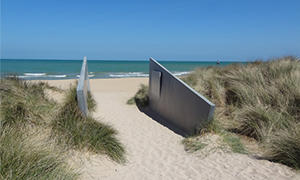
JUNO BEACH
The Germans did not believe an amphibious operation was possible in this sector, because of the need to clear offshore reefs.
Doubtless this is why the Atlantic Wall was weaker along this stretch of the coastline. Between Courseulles and Saint-Aubin there were no artillery positions like at Longues and Pointe du Hoc, the nearest being at Ver-sur-Mer and Ouistreham, in the Orne estuary (Sword sector).
This part of the coast, from Saint-Aubin to Graye-sur-Mer, was defended by the German 716th Infantry Division, under the command of General Richter. An older, fairly static division, it was also poorly equipped.
Juno beach was assigned to General Keller’s 3rd Canadian Infantry Division. Their orders were to clear the beach then head for Caen until they reached the Caen-Bayeux road, take the airfield at Carpiquet and link up with the two neighbouring British beaches.
Rough seas delayed the landing, initially planned for 7.30 a.m., by 10 minutes. This gave the Germans time to regroup after the naval bombardment. It also meant that the rising tide covered up a large number of mined obstacles on the beach, and many of the landing craft therefore hit them and were blown up or sunk.
The fiercest fighting took place on the outskirts of Courseulles harbour, which the occupying forces had turned into one of their main strongpoints. The infantrymen had to fight hard and alone at Bernières and Saint-Aubin, as the amphibian tanks that should have supported them had been launched too soon and sank during the crossing. Bernières was finally secured towards noon, and General Keller set up his headquarters there.

SWORD BEACH
The Sword beach sector was assigned to the British Army’s 3rd Infantry Division, under the command of General Rennie.
At 7.25 a.m., having had a very rough crossing, half of the tanks and troops began to land. Most of them attacked the central area between Hermanville and Colleville, momentarily leaving aside the highly fortified wings of this sector. The storming of the beach was horrendous, yet, despite heavy losses of both men and tanks, the British troops nevertheless managed to breach the beach defences at La Brèche.
The ‘Green Berets’ of Commando no.4 of Lord Lovat’s 1st Special Service Brigade were tasked with securing from behind the formidable defence system the Germans had built to defend Ouistreham. Commando no. 4 included Commandant Philippe Kieffer’s 177 men from the French First Battalion of Marines. When they regrouped in the ruins of a holiday village, after landing at Colleville and prior to attacking their objective in Ouistreham, thirty of them were already missing. Leaving their British comrades to take the battery on the other side of the canal, the French commandos attacked the bunker built by the Germans on the site of the destroyed casino. Despite two injuries, Philippe Kieffer, perched beside the gun turret of a DD tank (Duplex Drive) requisitioned nearby, led the assault. A few well-aimed shells silenced the guns in the casino and the commandos attacked.
Hermanville was liberated by the South Lancashire Regiment and Colleville by the Suffolk Regiment.
Ouistreham was liberated by the East Yorkshire Regiment and Royal Marine Commando n°4.
Having liberated Ouistreham, Commando n°4 headed for Bénouville bridge to relieve the troops from the 6th Airborne Division, while the British 3rd Infantry Division set off towards Caen, only to come to a standstill on arriving at the slopes of Perier ridge.
On the night of D-Day
Utah
The 4th Division was able to make contact with the paratroopers from the 101st Division. The fate of the men of the 82nd was more worrying.
Omaha
The captured area was much smaller than the planned objectives. A huge price was paid for this small achievement. The dead and the injured numbered 2,500. From that moment on, Omaha was known as Bloody Omaha. It was this beach that suffered the greatest losses on 6 June 1944. On the German side, the 352nd Division lost 1,200 men.
Gold
The 50th British Division reached the outskirts of Bayeux and Arromanches.
Juno
The Canadians reached Villons-les-Buissons, but were not able to take the Carpiquet airfield. It was early July before the Canadians were successful in continuing their advance. For 3 weeks, they fought the 12th SS Panzer Division Hitlerjugend, led by Kurt Meyer who set up a command post at the Ardenne Abbey.
Sword
Lovat's 1st Brigade reached the Bénouville bridge to support the 6th Airborne Division. The 3rd Division, however, headed towards Caen but was blocked by the Germans, who had had time to build a strong defence outside the city. It would take the British soldiers a month to enter the city of Caen.
On 6 June at midnight, more than 150,000 allied soldiers, including 23,000 paratroopers, landed on Normandy soil, supported by 20,000 vehicles of all different sizes. Fewer than 10,000 men were lost (killed, injured or captured), which is below the number predicted. While not all the objectives were met, overall the operation was a success.
Only the beachheads of Gold and Juno managed to link up. All the bridgeheads in Calvados were connected on 8 June. Four days later, the link with Utah was complete.
Now all the Allies had to do was reinforce the area along the coast, then push forward towards the south.